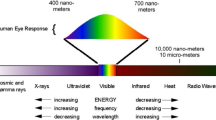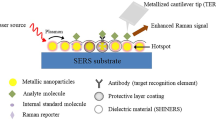Abstract
The fluorescence intensity of a sample placed on a metal grating pattern is enhanced due to excitation by the electric field of the grating-coupled surface plasmon resonance (GC-SPR). The dependence of the enhancement on groove depth and surface profile was studied with the aim of improving the sensitivity of fluorescence detection. The enhancement was found to depend on the groove depth, with intensity most enhanced on grating substrate of about 20 nm depth, which produced an intensity about 30 times greater than that on a flat borosilicate glass substrate. Rigorous coupled wave analysis calculation showed that the shape of the groove influenced GC-SPR, suggesting that controlling not only the depth but also the shape of the grating surface profile can be an important factor in improving the sensitivity of detection by fluorescence microscopy.
Similar content being viewed by others
References
D. Axelrod: Traffic 2 (2001) 764.
T. Liebermann and W. Knoll: Langmuir 19 (2003) 1567.
R. Robelek, L. Niu, E. L. Schmid, and W. Knoll: Anal. Chem. 76 (2004) 6160.
H. Raether: Surface Plasmons on Smooth and Rough Surfaces and on Gratings (Springer-Verlag, Heidelberg, 1988).
W. Knoll: Annu. Rev. Phys. Chem. 49 (1998) 569.
T. Liebermann and W. Knoll: Colloids Suf. A 171 (2000) 15.
K. Tawa and W. Knoll: Nucleic Acids Res. 32 (2004) 2373.
K. Tawa and K. Morigaki: Biophys. J. 89 (2005) 2750.
E. Kretschmann and H. Raether: Z. Naturforsch. A 23 (1968) 2135.
K. Tawa, H. Hori, K. Kintaka, K. Kiyosue, Y. Tatsu, and J. Nishii: Opt. Express 16 (2008) 9781.
J. Le Perchec, P. Quemerais, A. Barbara, and T. Lopez-Rios: Phys. Rev. Lett. 100 (2008) 066408.
M. G. Moharam, E. B. Grann, D. A. Pommet, and T. K. Gaylord: J. Opt. Soc. Am. A 12 (1995) 1068.
K. Kintaka, J. Nishii, A. Mizutani, H. Kikuta, and H. Nakano: Opt. Lett. 26 (2001) 1642.
W. S. Rasband: ImageJ (U.S. National Institutes of Health, Bethesda, ML, 1997–2007) [http://rsb.info.nih.gov/ij/].
Author information
Authors and Affiliations
Corresponding author
Rights and permissions
About this article
Cite this article
Hori, H., Tawa, K., Kintaka, K. et al. Influence of groove depth and surface profile on fluorescence enhancement by grating-coupled surface plasmon resonance. OPT REV 16, 216–221 (2009). https://doi.org/10.1007/s10043-009-0040-5
Received:
Accepted:
Published:
Issue Date:
DOI: https://doi.org/10.1007/s10043-009-0040-5




